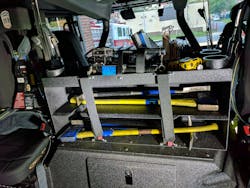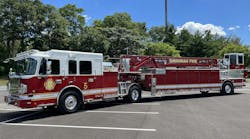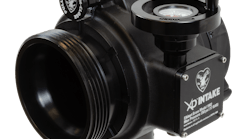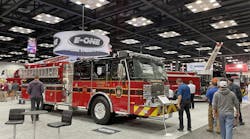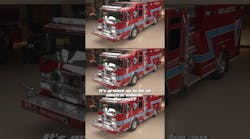Advancements in apparatus design can be traced back to several distinct areas, many of which are not affiliated with the fire service. Diesel engines and automatic transmissions have become the main power train components in our apparatus for over 50 years, yet it was the trucking industry’s success with these components that, over time, became standard in custom chassis units. Additionally, fire extinguishing agents, such as aqueous film-forming foam (AFFF), and ultra-high-pressure water pumps were developed by scientists working at the Naval Research Laboratory and by U.S. Air Force research personnel at Tyndall Air Force Base in Florida.
Compact spaces
More recently, EPA regulations covering diesel engine particulates and greenhouse gas emissions dramatically impacted engine-cooling packages, exhaust components and cab configurations. Consider that at one time an 84-inch-wide cab with rear-facing jump seats was the accepted standard for a custom fire cab. As higher-horsepower engines became available, the size of the engine enclosure reduced the available width for the jump seats, creating the need for a wider cab design. What was once simply a seat cushion with a padded back to provide a partially enclosed seating area was now being utilized for mounting of SCBAs on brackets with the top of the engine box used to mount hand lights, forcible-entry tools and other equipment. It soon became apparent that a wider cab design was needed to safely carry personnel and equipment.
Fast forward to 2009, and due to the larger engine packages and cooling requirements, cab widths have increased to 100 inches, with many departments still having issues with seat widths and finding sufficient space to accommodate radios, mobile data terminals (MDTs), gas meters, EMS equipment and personnel—all within a safe operating environment. Custom fire cabs have reached a practical limit regarding the physical size of what manufacturers can provide to the fire service. In addition, communities where older fire stations have space restrictions with respect to overall length, height and width limit the options that can be integrated into a new apparatus. At some point, apparatus committees need to consider the size and maneuverability of the vehicle in the response area while incorporating the required hose, tools and equipment to meet the mission of the department.
Navigation needs
Upon receipt of an alarm in the station, after the crew dons their protective gear and is seat-belted on the rig, the first order of business is to arrive at the correct location. Some departments rely upon MDTs and other equipment to provide incident information, while others utilize detailed map books.
The College Park, MD, Fire Department vehicles each carry multiple map books covering each response district, showing hundred block changes, hydrant and auxiliary appliance locations, access points in major complexes and other information. The department recently placed into service a new rear-mount ladder truck with cab and equipment mounting conducted by First Due Apparatus Solutions in Hollywood, MD.
The cab interior is outfitted with a custom-built map book box to accommodate multiple binders along with dual irons and forcible-entry tools in the crew area. Additionally, the exterior of the cab was designed with engineering personnel from Pierce Manufacturing to hold a 2½-gallon water extinguisher and New York roof hooks.
Areas of improvement
One of the common complaints of today’s rigs is the lack of adequate hip and foot room for the officer’s seat position. A possible solution to provide increased foot room is to use rocker switches adjacent to the officer’s seat in place of the traditional foot switches for the air horn and siren controls.
Painted steel front bumpers that are heavily reinforced to prevent cab intrusion in the event of an accident make for an important safety component that can be specified on most apparatus. Consideration should be given to providing recessed pockets for side- and front-mounted warning lights to reduce damage and protect these components.
When operating around apparatus, one of the most common injuries is slips and falls from the cab and other work surfaces. While the NFPA 1901 Standard identifies the requirement for step heights and minimum slip resistance, the use of aluminum tread plate for these areas does not provide the optimum safety for personnel.
When you have an opportunity, take a look at other vocational truck designs, such as construction equipment and snow plows, to review step surfaces and location of chassis components, such as air dryers and fuel filters. These are engineered to reduce maintenance and increase service life while monitoring operating costs. Together with fleet software programs and telematics, over time these concepts will be integrated into our apparatus.
There are several types of aggressive non-slip material, including Bustin, Grip Strut and Morton Cass, which can be incorporated into step surfaces for the cab, pump panel and rear body areas. For those departments that operate in locations where snow is prevalent, the open grating material is superior to a solid step surface.
Protection of the body and door hardware is dependent upon the design and construction of the rub rail assembly. Some rub rails are decorative in nature and do little to limit body damage, resulting in extended out-of-service repairs. Consideration should be given to specifying that the rub rail be spaced away from the body or a heavier poly style material that can be easily replaced. This material can also be provided across the rear of the apparatus tread plate step to reduce damage in the event of a backing accident.
Several concepts can be incorporated into pumpers to reduce out-of-service time and improve access to critical components. Apparatus equipped with hose wells in the running boards should be designed to float within the step area with angled forward walls. The right-side pump panel can be designed with full-height doors to quickly access the pump and piping once the adapters and fittings have been removed.
The NFPA 1901 Standard requires the hosebed area to be covered to reduce the chances of attack and supply hose being inadvertently deployed when the apparatus is in motion. There are several methods to accomplish this, with one recent innovation being a two-piece sliding cover fabricated of aluminum tread plate. Another version is having a lift-up tread plate cover at the front of the hosebed area that is held open with gas springs in conjunction with heavy box netting across the rear portion of the body.
Tool and equipment mounting is an art that requires some experience to fully utilize the space available inside apparatus bodies. Hinged doors enable the space in the upper portion of the compartment to be utilized for storage along with the inside door box pan for mounting of hand tools. Apparatus committees need to develop a complete tool and equipment list early in the specification development process to determine the size and weights for everything that will be carried on the vehicle.
In sum
Apparatus innovations can come from a variety of areas, including other heavy truck vocations, maintenance personnel and outside resources. When designing new or rebuilt apparatus, careful planning can provide a blueprint for success.
